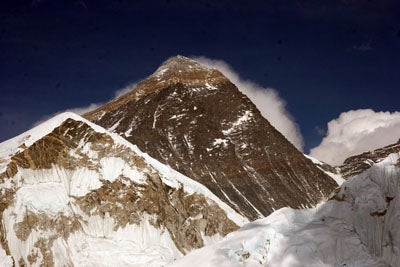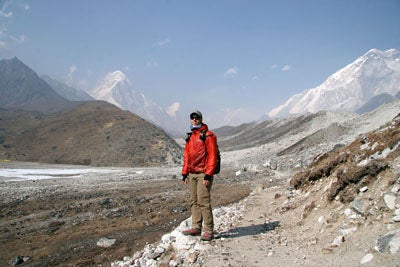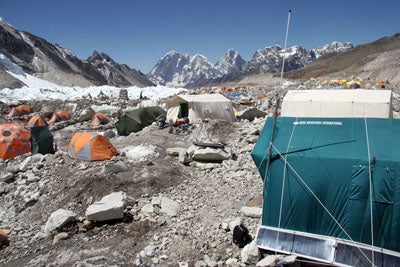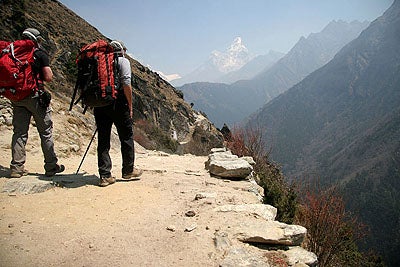
By
For three weeks in April, I put my entire life on hold to trek in the Khumbu Region of Nepal. As a part of , a major mountaineering initiative led bythe Canadian climber . I trekked for more than a week to reach Mount Everest Base Camp. The 17,500-foot tent city, which sits in a glacial field at the base of the world’s tallest peak, would serve as the launch pad for the climbers’ lofty 29,035-foot goal in the sky.
Though I was officially working–I was hired as the communications director for the first leg of Expedition Hanesbrands’ climb–the trip followed a similar trajectory that trekkers traditionally take to reach Base Camp, including a flight from Kathmandu to Lukla, and then eight days of hiking uphill village to village to acclimate to the increasingly thinner air en route to Base Camp.
Between my duties of blogging, posting videos, and shooting photos for the expedition’s Web site, , I had time to do day hikes, climb an 18,600-foot peak near Base Camp, and hang out with local Sherpas in lodges and tents along the route. In mid-April, I stumbled into Mount Everest’s Base Camp, a slight altitude headache accompanying me to my tent in the middle of a sea of ice and jumbled stone.
Climbing Mount Everest is an obvious achievement. But just trekking to Base Camp is a feat that requires strong lungs, leg muscles that can go for hours uphill, and aphysiology that will adapt to air that suffers a significant deficit in the oxygen department.

Altitude, not distance or terrain, was the main hurdle on my journey. The trek began at about 9,000 feet in the village of Lukla. It topped out at Base Camp with stops to sleep at 11,000 feet, 13,000 feet, 16,000 feet, and higher along the way.
Trekkers sweat and breathe hard on the trail, the thin air resulting in headaches and fatigue. You move slow. You stop often. In some villages, a planned rest day keeps you at the same lodge for two nights in a row.
The right equipment keeps you going. For gear, I used mainly common backpacking items, including a mid-size pack and trail-running shoes, not boots, most of the way. One thing I did not bring–a dust mask–is highly recommended. Trekkers, porters, and yaks kick up clouds of dust on the dry trail. Inhaling the particulate results in something known locally as the Khumbu cough.
Instead of a mask, I wore a Buff scarf pulled up over my face. The thin Buff fabric did a good job filtering dust, though it was often too warm and would fog my sunglasses if I breathed too much out of my nose.

Because the expedition was sponsored by Hanesbrands, we wore the company’s Duofold long-sleeve tops. One piece I liked, the Duofold Varitherm Wool base layer, was comfortable across a range of temperatures. Bonus: Because of its wool fabric blend, which is a natural antimicrobial material, the top did not stink even after a few days’ use.
In general, on the trek I wore the same clothes for several days straight. Look for wool and other antimicrobial or treated fabrics that can accommodate multiple days between a washing. I banked on pieces including a lightweight jacket from Ibex, khaki synthetic pants from Rail Riders, and wool-blend Duofold base-layer bottoms. This kind of clothing is a good way to cut the bulk from the gear you bring.
Many trekkers use trekking poles. Seems obvious enough. I brought along a pair of lightweight Leki poles. But after the first day, I stowed them and did not take them out again. Except for a few big climbs, the Mount Everest trail is generally wide and easy. If you’re in good shape–and if your porter is carrying much of your load, which is par for the course in Nepal–you might consider leaving poles at home.

If you like poles for stability, have bad knees, etc., by all means bring poles. But if you’re fit and unburdened by a big pack, poles can be superfluous. They can slow you down. More detrimental, trekking poles can keep you consistently looking down–not up at the mountains!–for the next spot on the ground to stab.
It’s not really gear, but medications can be essential along the Mount Everest trail. To be sure, ask a doctor for anything health related. But for me, ibuprofen aided with headaches. A stomach illness early in the trip prompted me to do a course ofazithromycin, an antibiotic. I was better in one day on this drug. For altitude, Diamox (generically, acetazolamide) seemed to help my body adapt to the thin air.
Obvious small essentials on my trek included sunscreen, lip balm, and hand-wash sanitizer. I kept a pack of tissues and some baby wipes handy. All these items were stowed in hip-belt pockets on my pack, easily accessible throughout the day.
Finally, sunglasses are mandatory, too. Get a good pair. At Base Camp, at 17,500 feet, you are higher in the sky. In Nepal, near Mount Everest, you are truly closer to the sun.
–Stephen Regenold blogged live from the Everest region in April at and on the Gear Junkie’s .